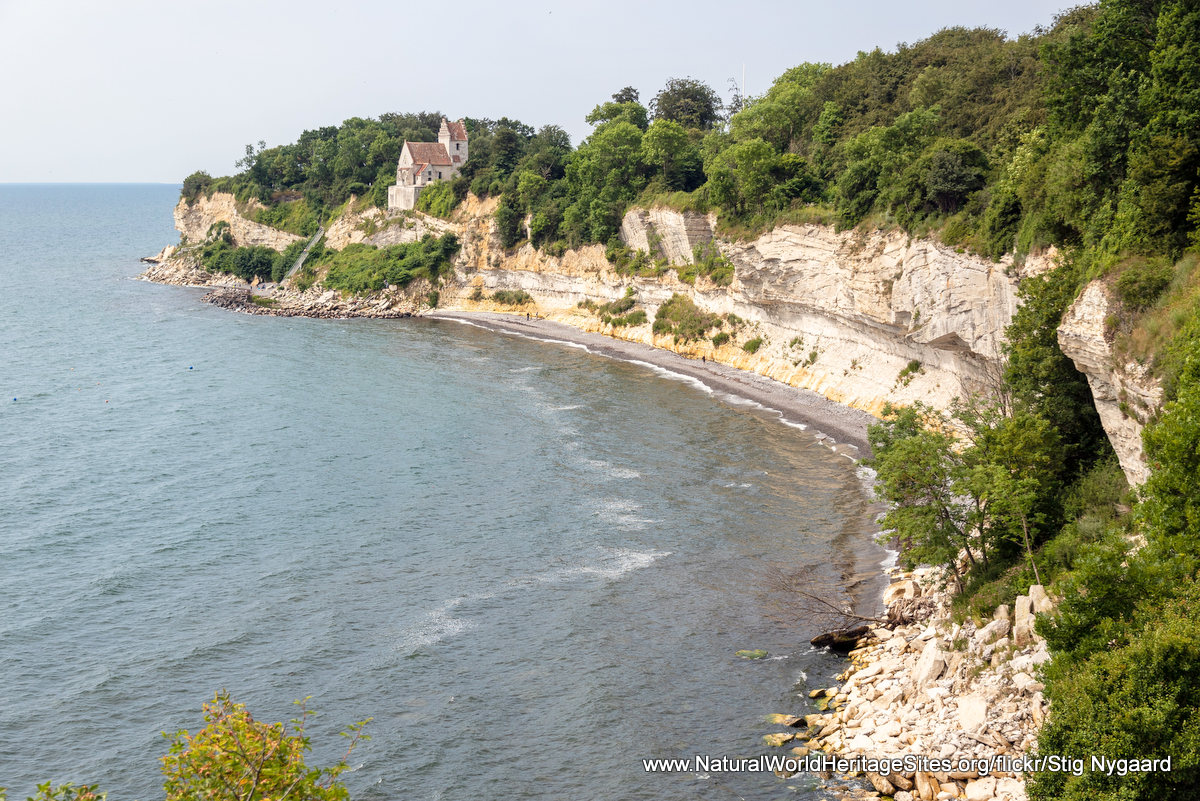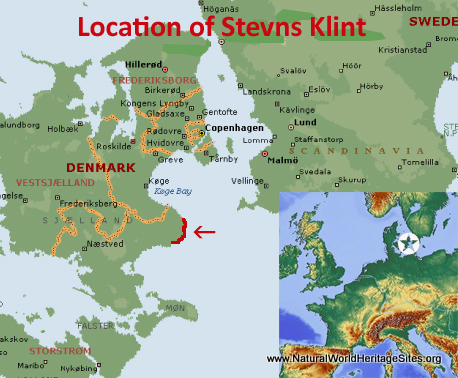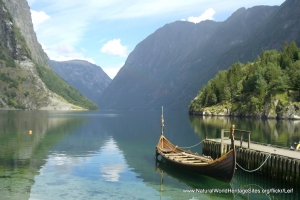EXPLORE Stevns Klint with this slideshow, check the location map and get all the facts and information below.
For slideshow description see right or scroll down (mobile). Click to view slideshow
Location and Values: Stevns Klint is a 15km-long fossil-rich coastal cliff located about 50km south of the Danish capital, Copenhagen. It is considered to be the most significant and readily accessible site (amongst many hundreds of places with similar attributes) to see the fossil evidence of the ash cloud which covered the Earth after a massive meteorite crashed into the planet (near Mexico’s Yucatan peninsula) about 65 million years ago. This event is believed to have caused the extinction of about 50% of life on Earth and brought about the end of the Age of Dinosaurs.
The cliffs at Stevns Klint expose rock strata that clearly show the layer of ash that settled back to Earth following the meteorite impact, known to geologists as the K/T boundary, with older rocks from the Cretaceous Period (the Age of Dinosaurs) below it, and more recent rocks (from the Tertiary period) above. The cliffs at Stevns Klint provide a detailed fossil record of a marine ecosystem covering a period of about one million years before, during and after the meteorite strike. Three distinct communities of fossil animals can be distinguished namely (1) a climax pre-impact community of marine species, (2) a depleted community of animals that survived the mass extinction and (3) a richer community developing over time during a recovery period. The fossil record shows which taxa became extinct and which survived and reveals the time-scale and evolutionary processes involved in the subsequent development of a new marine fauna similar to what exists on Earth today.
Conservation Status and Prospects. According to IUCN’s Conservation Outlook Assessment (2020) the conservation status of Stevns Klint is ‘good’. The IUCN report notes that the site enjoys highly effective management with a strong legislative framework and good collaboration between the various authorities, local community and private landowners. The site is divided into two sections by a chalk quarry that has destroyed a short section of the cliff, and the possible expansion of this quarry would need to be carefully managed to minimize any adverse impact on the values of the site, as would a planned wind farm development. Following the world heritage listing an increase in visitors is expected, with the attendant risk of uncontrolled fossil collecting.
Links:
Google Earth
Official UNESCO Site Details
IUCN Conservation Outlook
UNEP-WCMC Site Description
Slideshow description
The slideshow ‘tells the story’ of Stevns Klint with a portfolio of photos that show the site from a variety of perspectives, including an aerial view, and views from the cliff tops as well as the rocky shoreline below. There are a number of clearly defined strata, but the prominent K/T boundary can be easily distinguished as a thicker, darker line about half-way up the chalky-white cliff with the older (Cretaceous) rock strata tending to be undercut by wave action below the boundary line, while more recent rocks from the Tertiary period create a bit of an overhang (or in places lie in piles where they have broken off onto the beach). The final section of the slideshow includes a small selection of photos from the official UNESCO nomination dossier showing detail of the ash sediment layer and some museum displays of typical fossils from the site. These include the shells of small marine creatures, and a shark’s tooth from the marine environment that existed here, but nothing as big or impressive as a dinosaur!
The following Flickr photographers and other sources are acknowledged with thanks for their contributions to this slideshow: Mikko Muinonen, Beth, CucombreLibre, Illohm, Frank Stjerne, David, Stig Nygaard, UNESCO Nomination dossier, paleontica.org/Johan Vellekoop, paleontica.org/Taco Geertsema.
Factfile
Website Category:
Fossil Record
Area: 0.5 km2
Inscribed: 2014
UNESCO Criterion:
- Fossil record (viii);




